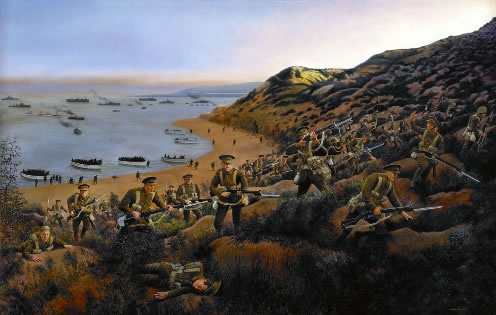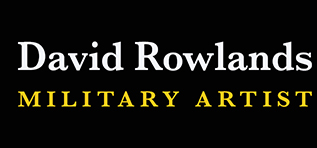« Click on Picture to
Return »
 |
|
The Landing at Anzac Cove, Gallipoli, 25 April 1915
In 1915, after weeks of intensive training, the soldiers of the Australian and New Zealand Army Corps were carried in ships from the island of Lemnos to force a landing on the Gallipoli peninsula. Early on the morning of 25th April, in complete darkness, troops climbed down from battleships of the Royal Navy into small rowing boats. Steam pinnaces then towed strings of these boats, packed with soldiers, toward the shore in strict silence. In order to prevent an accidental discharge from a rifle, their magazines were empty; the men were under orders that no shots were to be fired before daylight, and the attack was to be undertaken at bayonet point. The sea was as smooth as satin.
The Turkish defenders at last became aware of their approach and opened up with small arms fire, causing casualties. Nearing the shore, the steamboats cast off their tows and the boats were rowed furiously towards the beach. The first instalment of the Anzacs landed under cover of darkness around a little promontory topped by a hill called Ari Burnu. They advanced up the steep slopes and captured the Turkish machine gun position at the top.
Anzacs of the second instalment followed quickly, carried in River class destroyers which approached to within 500 yards of the shore. These men entered the rowing boats and were landed on a much wider shoreline (both north and south of Ari Burnu). My painting shows soldiers of the 3rd Infantry Brigade landing in the little bay which became known as Anzac Cove. Ari Burnu is the hill at the northern end of the beach. As dawn breaks, the destroyers can be seen offshore: from right to left, HMS Ribble, Usk, Chelmer and Scourge. (Other destroyers were to our left, out of view). They were obliged to wait for the return of the rowing boats before they could clear all their troops. Beyond the destroyers are the transport ships Galeka and Novian. Standing farther out to sea is the battleship HMS London, which had discharged soldiers of the first wave. In the far distance is Suvla Bay.
The men were ordered to fix bayonets the moment they landed from the boats; they then doubled across the shingle, quickly removed their packs and loaded their magazines with five or ten rounds before scaling the steep slopes. They climbed up the deep gullies in the sandstone rocks, engaging Turkish snipers hidden in the scrubby vegetation. The Turkish artillery did not open fire on them till about an hour after the first Anzacs landed.
Further waves of troops were disembarked from ships, and by noon 10,000 men were ashore at Anzac Cove.
"This painting is the most accurate depiction to date of the dawn landing at Anzac Cove on 25th April 1915. It captures the essence of the action some thirty minutes after the initial landing and strips away the myth associated with this iconic action in Australian military history. Clearly, the artist has researched the subject meticulously, down to the details of the uniforms, headdress and equipment worn that day, the terrain, the shipping offshore, and the light casualties sustained by the Australians around the cove at the beginning of the action."
Brigadier Chris Roberts AM, CSC (Rtd), Australian Army History Unit and author of a volume for the Australian Army Campaign Series on the landing at Anzac.
In 2014, I visited Anzac Cove and climbed up this slope to Plugge’s Plateau.
Medium: Oil on Canvas
Printed image size(s): B2 only (58 x 38 cm)
Price(s): £75
|
|



